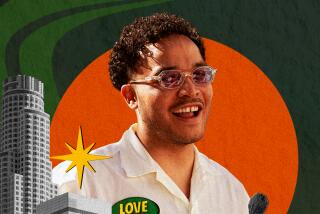Diamond-Cutting Trade Attracts Latinos
- Share via
NEW YORK — A mixture of oil and diamond dust shoots up into the air each time a rough diamond is pressed to the cutting wheel. The grime has been building up on the windows, walls and benches of New York City’s diamond factories for more than 70 years.
For three generations thousands of Jewish cutters passed through these factories above the retail jewelry stores on 47th Street between 5th and 6th avenues. But the number of Jewish cutters is rapidly diminishing, and today’s new generation is increasingly Latino.
As many as half of New York’s diamond cutters are Puerto Rican, Cuban or Dominican, factory owners say. They are filling positions previously held by Jewish immigrants who came to the United States in the aftermath of World War II.
Latinos became involved in the diamond business in the mid-1970s when companies such as Harry Winston Inc. and Lazare Kaplan Inc., opened stores in Puerto Rico to capitalize on federal tax breaks and the large pool of trainable, inexpensive labor. A slump in diamond sales in the early 1980s, however, forced many of the Puerto Rican factories to close and a generation of cutters to come to New York seeking work.
Over time, as more Jewish cutters retired, these men have found jobs on 47th Street. Alvin Fernandez, who emigrated from the Dominican Republic 10 years ago, worked as a doorman and a machinist before Augustine Cotto taught him the trade. Cotto, a cutter for Harry Winston in Puerto Rico, came to New York when Winston’s Puerto Rico factory closed.
Today, he and Fernandez are two of eight Latino cutters who rent wheels from the Trielle diamond company. Learning the trade is an arduous process. Fernandez said it was a year before he was making as much money as the other cutters in the shop. While he was learning, Cotto also lost money. “I would run over every couple of minutes to ask Augustine how to cut the stone,” Fernandez said. “It took us both twice as long to finish our work.”
In addition to shaping the rough stone, cutters remove tiny imperfections. Their goal is to cut away as many flaws as possible while preserving the stone’s weight.
“How much of the diamond you cut away can often mean the difference between a profit and a loss for the factory,” Fernandez said. “Sometimes you go crazy looking for the best way to cut it.”
Most of New York’s diamond cutters rent their wheels from one of the city’s diamond factories and are paid for piecework. While the majority of the stones they cut come from the factory where they rent, they are technically independent contractors and can cut for whomever they please.
A good cutter can earn as much as $65,000 in a year. Once they have gained enough experience, some will buy, cut, and sell their own stones, slowly building independent businesses, capable of generating hundreds of thousands of dollars in profits each year. However, few Latinos have been able to make the jump from the factory floor. Many say because they are not Jewish they do not have the connections they need to sell their stones and start their own businesses.
“A Puerto Rican has to be twice as good to make it as a cutter,” said Bob Ponce, who got his start cutting 20 years ago in Puerto Rico. “If you’re going to cut or trade your own stones in the diamond district you need people who trust you. The Jews, they work together and go to synagogue together--that’s a big edge.”
It is inevitable, however, that the better cutters of this generation will break out of the pack, diamond experts say. They blame a general slump in diamond sales over the last few years, coinciding with the rise in Latino cutters, for the low number of Latinos cutting and trading their own stones. “As long as there has been diamond cutting the leaders of the diamond industry have worked their way up from the factory floor,” said Lloyd Jaffe, president of the American International Diamond Assn. “It takes guts, savvy, and hard work to make it. But I see no reason why today’s cutters won’t follow the same course.”


